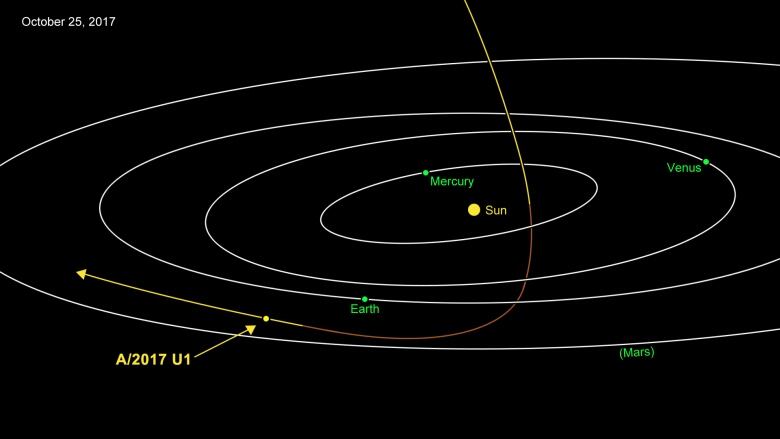Canadian astronomer spots 'visitor' from beyond our solar system
'Astronomers have been looking for this for more than a century,' professor says

No, it's not an alien, but we may have just been visited bysomething that originated beyond our solar system.
For the first time, astronomers have observed something passing through our solar system that has likely travelled light years to get here.
The object which initially some believed to be a comet, but is now believed to be an asteroid was discovered on Oct. 19 by Canadian Robert Werykat the University of Hawaii Institute for Astronomy.
Weryk, who is a post-doctoral researcher, was going through data from the Pan-STARRSsurvey, a project thatscans the sky for near-Earth objects.
Weryk is part of a group searchingfor near-Earth objects, so when he spotted something, he initially thought it wasan asteroid or comet orbiting the sun.
But not this time.
Weryk had seen the object in image archives from the night before. And he knew something was different.
"At first it was a 'that's weird,'and then we want to double-check the data," Weryktold CBC News."But once we had confirming images from a colleague, we were pretty confident that this was coming from outside the solar system."
How do astronomers determine whether something is bound in an orbit around the sun or unbound? It's all about speed.
Astronomers have been looking for this for more than a century.- Peter Brown, Western University
To be bound in an orbit around the sun at Earth's distance, an object would need to move around 42 kilometres per second. However, when this object was passing through, it was moving at 44 kilometres per second. As well, it appeared that the trajectory of the object was more than enough to resist the gravitational pull of the sun.
After getting other observations to confirm the object's orbit, Werykcalled one of his previous astronomy and physicsprofessors from Western University, Peter Brown, who specializes in meteor physics. Brown was doubtfulat first.
"Everybody was quite skeptical about this ... but by the time it was announced just a few days ago it was pretty clear from the three dozen observations there was no way to fit a bound orbit to this object," Brown said.
"Astronomers have been looking for this for more than a century," he said.
"We expect that, if other planetary systems formed the way ours did, the vast majority of comet-like and asteroid-like bodies don't get incorporated into the planets, they get scattered out of the system. So there should be tons of these things ... all over the galaxy."
Astronomers have neverspotted something like this before, which gave some planetary scientists pause, Brown said.
The problem was that astronomers weren't looking for that kind of motion for an object, which is different from that ofsolar system objects. Now that they know what to look for,Weryk and Brown hope that more of these interstellar interlopers will be found.

Brown noted that the object could still be something else. Althoughit's highly unlikely, a very large, extremely distant planet could have altered the orbit of something far out in our solar system.
"It's almost such a long shot, it's not worth mentioning," he said.
The object known as A/2017 U1 has only been observed for just over a week, and it will be too faint to observe within a few days. So this is the only time astronomers can study it.
If you're wondering where this object came from, there's no way of knowing, because during the tens of thousands of years this object has been flying through space, the starshave also been moving (we all orbit the centre of the galaxy).
Weryk,who had spent his time at Western Universitysearching for meteors small bits of dust and debris in space from beyond our solar system, finds it ironic that he spotted something so large.
"It's almost like closure," he said. "I actually forwarded the discovery email to Peter and said, 'Hey, I finally found one 13 years later.' I thought that was funny."












_(720p).jpg)


 OFFICIAL HD MUSIC VIDEO.jpg)
.jpg)



























































































